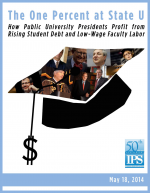Accueil > Évaluation / Bibliométrie / Primes > "Parce que je le vaux bien" > Student Debt Grows Faster at Universities With Highest-Paid Leaders, Study (...)
 Student Debt Grows Faster at Universities With Highest-Paid Leaders, Study Finds. New York Times - Tamar Lewin - 18 may 2014
Student Debt Grows Faster at Universities With Highest-Paid Leaders, Study Finds. New York Times - Tamar Lewin - 18 may 2014
lundi 19 mai 2014, par
At the 25 public universities with the highest-paid presidents, both student debt and the use of part-time adjunct faculty grew far faster than at the average state university from 2005 to 2012, according to a new study by the Institute for Policy Studies, a left-leaning Washington research group.
The study, “The One Percent at State U : How University Presidents Profit from Rising Student Debt and Low-Wage Faculty Labor,” examined the relationship between executive pay, student debt and low-wage faculty labor at the 25 top-paying public universities.
The co-authors, Andrew Erwin and Marjorie Wood, found that administrative expenditures at the highest-paying universities outpaced spending on scholarships by more than two to one. And while adjunct faculty members became more numerous at the 25 universities, the share of permanent faculty declined drastically.
“The high executive pay obviously isn’t the direct cause of higher student debt, or cuts in labor spending,” Ms. Wood said. “But if you think about it in terms of the allocation of resources, it does seem to be the tip of a very large iceberg, with universities that have top-heavy executive spending also having more adjuncts, more tuition increases and more administrative spending.”
Since the 2008 financial crisis, the report found, the leaders of the highest-paying universities fared well, largely at the expense of students and faculty.
“Like executives in the corporate and banking sectors, public university presidents weathered the immediate aftermath of the fall 2008 financial crisis with minimal or no reductions in total compensation,” the report said.
While the average executive compensation at public research universities increased 14 percent from 2009 to 2012, to an average of $544,554, compensation for the presidents of the highest-paying universities increased by a third, to $974,006, during that period.
The Chronicle of Higher Education’s annual survey of public university presidents’ compensation, also released Sunday, found that nine chief executives earned more than $1 million in total compensation in 2012-13, up from four the previous year, and three in 2010-11.
The median total compensation of the 256 presidents in the survey was $478,896, a 5 percent increase over the previous year.
But, The Chronicle found, chief executives were hardly alone among the highest-paid public university officials. Athletic coaches made up 70 percent of the public university employees earning more than $1 million last year, and medical doctors another 20 percent.
As in several past years, the highest-compensated president, at $6,057,615 in this period, was E. Gordon Gee, who resigned from Ohio State last summer amid trustee complaints about frequent gaffes. He has since become the president of West Virginia University.
In the study by the Institute for Policy Studies, Ohio State was No. 1 on the list of what it called the most unequal public universities. The report found that from fiscal 2010 to fiscal 2012, Ohio State paid Mr. Gee a total of $5.9 million. During the same period, it said, the university hired 670 new administrators, 498 contingent and part-time faculty — and 45 permanent faculty members. Student debt at Ohio State grew 23 percent faster than the national average during that time, the report found.
Others on the “most unequal” list were Pennsylvania State University, the University of Minnesota, the University of Michigan and the University of Washington.


